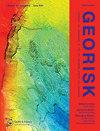Spatiotemporal prediction of landslide displacement using deep learning approaches based on monitored time-series displacement data: a case in the Huanglianshu landslide
IF 4.8
3区 工程技术
Q1 ENGINEERING, GEOLOGICAL
Georisk-Assessment and Management of Risk for Engineered Systems and Geohazards
Pub Date : 2023-01-02
DOI:10.1080/17499518.2023.2172186
引用次数: 5
Abstract
ABSTRACT The use of deep learning approaches to predict landslide displacement based on monitored time-series data is an effective method for the early-warning of landslides. Currently, most prediction models focus on the temporal correlation of displacements from a single monitoring point, ignoring the spatial influence of other monitoring points. To fully consider the spatiotemporal features of the displacement data, this paper develops three deep learning models based on graph convolution networks to spatiotemporally predict the landslide displacements of the Huanglianshu landslide. Specifically, we first establish a fully connected graph to represent the spatial relationships of all the deployed monitoring points. Second, we develop a temporal graph convolutional network-long short term memory (TGCN-LSTM) model and an Attention-TGCN model based on the temporal graph convolutional network-gate recurrent unit (TGCN-GRU) deep learning model and employ the three models to spatiotemporally predict displacements of the Huanglianshu landslide. The proposed spatiotemporal prediction models accurately predict the displacements at seven monitoring points, with a maximum R 2 of 0.85 at the individual monitoring points. The comparative results show that the proposed Attention-TGCN model achieves the highest spatiotemporal prediction accuracy, and the accuracy of the Attention-TGCN model can further improve after considering the movement of the monitoring points.基于时间序列位移监测数据的深度学习滑坡位移时空预测——以黄连树滑坡为例
摘要基于监测的时间序列数据,使用深度学习方法预测滑坡位移是滑坡预警的有效方法。目前,大多数预测模型都关注单个监测点位移的时间相关性,忽略了其他监测点的空间影响。为了充分考虑位移数据的时空特征,本文开发了三个基于图卷积网络的深度学习模型,对黄连树滑坡的位移进行时空预测。具体来说,我们首先建立一个全连通图来表示所有部署的监控点的空间关系。其次,我们在时态图卷积网络门递归单元(TGCN-GRU)深度学习模型的基础上,开发了时态图卷积网长短期记忆(TGCN-LSTM)模型和注意力TGCN模型,并利用这三个模型对黄连树滑坡的位移进行了时空预测。所提出的时空预测模型准确预测了七个监测点的位移,单个监测点的最大R2为0.85。比较结果表明,所提出的Attention TGCN模型实现了最高的时空预测精度,并且在考虑监测点的移动后,Attention TGCN模型的精度可以进一步提高。
本文章由计算机程序翻译,如有差异,请以英文原文为准。
求助全文
约1分钟内获得全文
求助全文
来源期刊
CiteScore
8.70
自引率
10.40%
发文量
31
期刊介绍:
Georisk covers many diversified but interlinked areas of active research and practice, such as geohazards (earthquakes, landslides, avalanches, rockfalls, tsunamis, etc.), safety of engineered systems (dams, buildings, offshore structures, lifelines, etc.), environmental risk, seismic risk, reliability-based design and code calibration, geostatistics, decision analyses, structural reliability, maintenance and life cycle performance, risk and vulnerability, hazard mapping, loss assessment (economic, social, environmental, etc.), GIS databases, remote sensing, and many other related disciplines. The underlying theme is that uncertainties associated with geomaterials (soils, rocks), geologic processes, and possible subsequent treatments, are usually large and complex and these uncertainties play an indispensable role in the risk assessment and management of engineered and natural systems. Significant theoretical and practical challenges remain on quantifying these uncertainties and developing defensible risk management methodologies that are acceptable to decision makers and stakeholders. Many opportunities to leverage on the rapid advancement in Bayesian analysis, machine learning, artificial intelligence, and other data-driven methods also exist, which can greatly enhance our decision-making abilities. The basic goal of this international peer-reviewed journal is to provide a multi-disciplinary scientific forum for cross fertilization of ideas between interested parties working on various aspects of georisk to advance the state-of-the-art and the state-of-the-practice.

 求助内容:
求助内容: 应助结果提醒方式:
应助结果提醒方式:


